You can preserve apples for up to six months using wood ash, a centuries-old method that's both sustainable and chemical-free. To start, gather completely cooled hardwood ash and firm, unblemished apples like Golden Delicious or Granny Smith. Place a 1.5-inch layer of sifted ash in a metal container, then carefully arrange your apples so they don't touch each other. Cover with another thin layer of ash and repeat. Store your container in a dark place at 32-40°F with 80-90% humidity. While this traditional technique requires proper safety measures and monitoring, the reward is naturally preserved apples that maintain their flavor and texture. Discover how this ancient practice can transform your harvest storage approach.
Historical Origins of Wood Ash
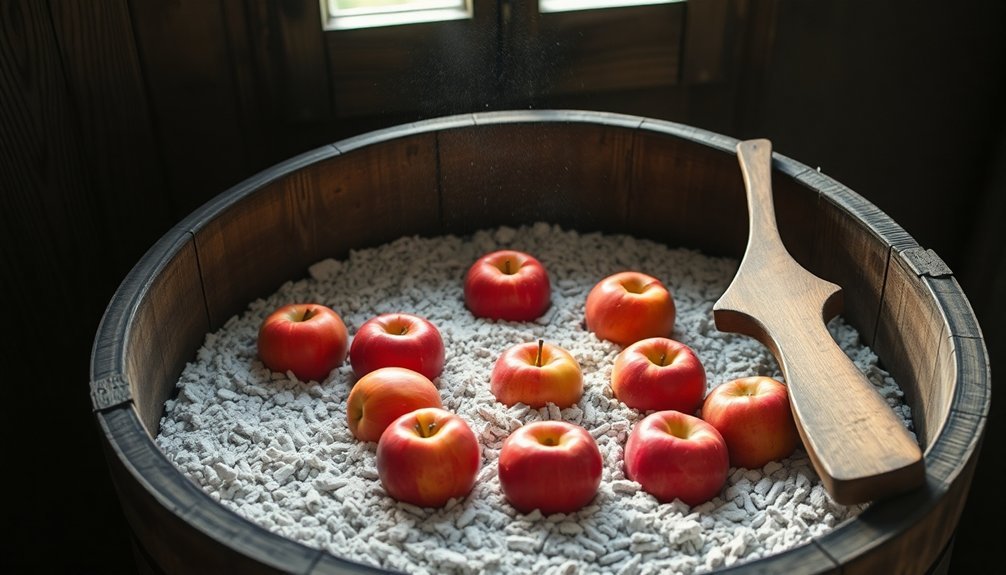
The resourceful nature of wood ash has been woven into human civilization for centuries. You'll find its earliest significant commercial use in the United States dating back to the 1700s, where it played a key role in producing potash for fertilizers and alkali for industrial applications. This versatile substance became a cornerstone of early American agriculture and manufacturing.
When you examine wood ash's composition, you'll discover it's remarkably similar to agricultural lime, containing essential elements like calcium, potassium, phosphorus, and magnesium. These nutrients weren't just essential for crop production – they made wood ash invaluable for various practical applications. One cord of wood could produce 5-8 gallons of ash, providing households with an abundant resource for daily needs.
In New England, you'd have found it being used to make lye for soap production and as a cleaning agent for glass, silver, and pewter.
Wood ash's significance extended beyond industrial uses. You can trace its importance through archaeological findings, where ash layers have helped preserve historical artifacts and agricultural practices.
While its commercial use eventually declined as newer potash production methods emerged, wood ash's historical importance has left an indelible mark on human development and resource utilization.
Preparing Wood Ash Storage Containers
You'll need to select a clean metal container with a tight-fitting lid and sturdy handles for safely storing your wood ash preserves.
When layering the ash, maintain a thickness of 1-2 inches between each layer of apples to guarantee proper preservation without compacting. Since wood ash has high potassium content, it helps create an environment that naturally preserves fruit while providing nutrients.
Make sure you're sealing the container completely after each use to keep moisture out and prevent the ash from becoming damp or ineffective.
Clean Container Selection Steps
Properly selecting and preparing storage containers for wood ash is essential for both safety and effectiveness when preserving apples. You'll need to choose metal containers with tight-fitting, airtight lids to guarantee your wood ash stays secure and prevents oxygen from reaching any potential hot coals.
Don't use paper, plastic bags, or cardboard boxes, as these materials can't safely contain ash and may lead to fires. Your metal container should seal completely to prevent ash from spilling and keep moisture out.
Before you begin storing ash, make sure you've selected a container that won't tip over easily and can withstand both heat and weight. Hot coals can stay active for up to four days within ash piles, making proper container selection crucial.
You'll need to place your container on a non-combustible surface like concrete, brick, or stone. Keep it away from your home, garage, wooden decks, or any flammable materials.
Before adding ash to your clean container, wet it thoroughly to eliminate any remaining embers. Even if the ash appears cool, always check for live coals that could reignite.
Regular inspection of both the container and storage area will guarantee your ash remains safely contained for apple preservation.
Safe Ash Layer Thickness
When preserving apples in wood ash, maintaining correct layer thickness proves essential for successful storage. Start by spreading a 1.5-inch (4 cm) layer of sifted hardwood ash at the bottom of your clean container. This initial layer creates a protective foundation that helps manage humidity and prevents decay.
As you layer your apples, cover each row with a thin, uniform layer of ash, ensuring there aren't any gaps between fruits. You'll want to maintain consistent thickness throughout to create ideal preservation conditions. The ash shouldn't be too thick or too thin – just enough to completely surround each apple.
- You'll feel a deep connection to your ancestors as you practice this time-tested preservation method that's sustained families through winters for generations.
- You'll experience satisfaction watching your harvest transform into a lasting food source, knowing you're reducing waste and becoming more self-reliant.
- You'll gain confidence in your preservation skills as you master this traditional technique, preparing yourself for a more sustainable future.
Remember to adjust the ash thickness based on your apples' size, ensuring each fruit is properly cushioned and protected from moisture and decay agents.
Proper Container Sealing Requirements
Building on proper ash layering techniques, safe container preparation and sealing stands as the next vital step in apple preservation.
You'll need to select a metal container with a tight-fitting lid to guarantee your apples remain properly preserved and protected. Don't use wooden containers, as they pose a fire hazard when storing wood ash.
Your container must have an insulated bottom to help manage heat retention, which is essential for the preservation process. Place it on a non-combustible surface like cement or brick, guaranteeing proper ventilation in the storage area.
You'll want to avoid confined spaces or areas where ash dust could become airborne.
When sealing your container, confirm the lid fits securely to prevent ash from spilling out and moisture from getting in. Before closing, check that your ash is completely dry to minimize combustible dust hazards.
If you're handling the ash during the sealing process, don't forget to wear proper PPE, including gloves, goggles, and a dust mask. Apply barrier cream to protect your skin from the ash's drying and corrosive effects.
This careful attention to container selection and sealing will help guarantee your apples preserve successfully.
Selecting Quality Apples
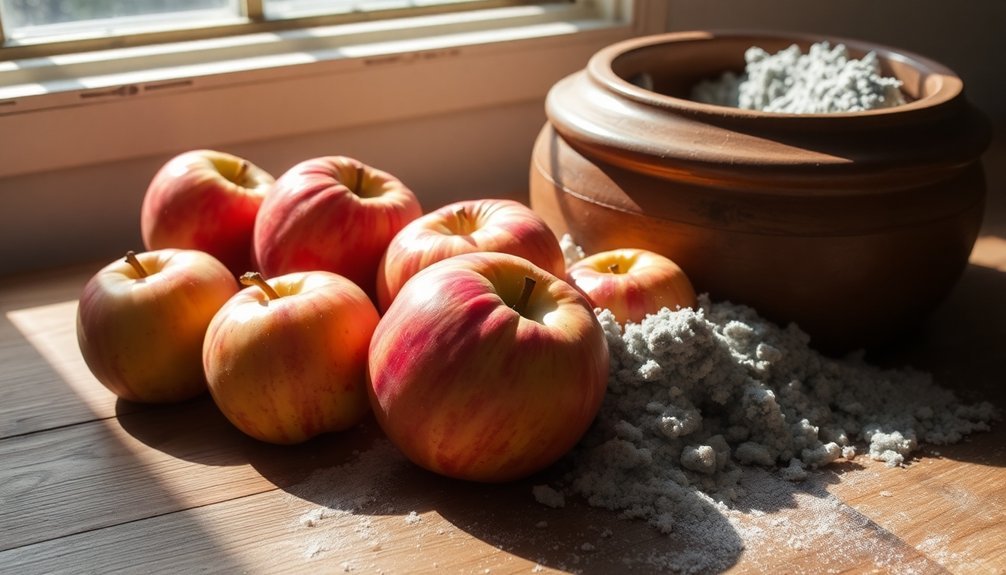
Successful apple preservation begins with selecting the right fruit. You'll want to choose crisp, firm varieties like Golden Delicious, Rome Beauty, or Granny Smith that offer a perfect balance of sweetness and tartness. These varieties maintain their texture well during the preservation process and won't turn mealy when stored in wood ash.
When inspecting apples, look for unblemished fruit with intact skin. Fresh, in-season apples harvested during September or October will give you the best results. Don't select apples that show any signs of decay or those that have been stored for extended periods, as they won't preserve well.
- Feel the satisfying weight of each apple in your palm – a good apple should feel heavy for its size, promising the juicy flesh within.
- Breathe in the crisp, sweet aroma that hints at the apple's readiness for preservation.
- Take pride in selecting perfectly firm fruits that will carry autumn's bounty into winter months.
Before beginning the preservation process, wash your hands thoroughly and clean all surfaces. Gently clean each apple under cold running water, but avoid soaking them. Pre-treat sliced apples with ascorbic acid to prevent browning and maintain their appetizing appearance.
Wood Ash Safety Guidelines
When collecting wood ash for apple preservation, you'll need to source it from clean hardwood fires and guarantee it's free from any non-wood materials or contaminants.
You must protect yourself by wearing gloves and goggles while handling the ash, and don't forget to dampen it slightly to prevent dust clouds.
Store your collected ash in a covered metal container placed on a non-combustible surface at least three feet away from flammable materials.
Selecting Clean Ash Sources
Choosing the right wood ash source is essential for safely preserving apples. You'll want to focus on residential woodstove ash, as it's typically cleaner and more consistent than commercial sources.
Make certain you're only using ash from untreated, natural wood – never use ash from fires that burned painted wood, plastics, or other synthetic materials, as these can contain harmful chemicals that could contaminate your apples.
For ideal preservation results, select ash that's been properly cooled for at least 96 hours and stored in covered metal containers.
You'll need to verify the ash is dry and free from residual combustible material. Local sources are preferable, as they reduce transportation risks and guarantee freshness.
- You're carrying on an ancient preservation tradition that's sustained families through countless winters – there's something deeply satisfying about that connection to our ancestors.
- You're taking control of your food preservation methods, free from modern chemical preservatives and artificial additives.
- You're participating in a sustainable practice that transforms a waste product into a valuable preservation resource.
Remember to collect your ash on humid, low-wind days to minimize dust dispersion, and always keep it stored at least 10 feet away from buildings and flammable materials.
Safe Handling Procedures
Now that you've identified your ash source, proper safety protocols must guide every step of handling wood ash for apple preservation.
You'll need to verify your wood ash has cooled completely – wait at least 96 hours, but preferably a week, before collecting it for use. Even if the surface feels cold, hidden hot spots can lurk beneath, so don't rush this vital step.
Always transfer your ash using a metal container with a tight-fitting lid – never use plastic, cardboard, or paper containers.
Keep your storage container at least 10 feet away from buildings, wood piles, and other flammable materials. You'll want to store it in a dry area to prevent nutrient leaching, which could affect the ash's preservative qualities.
Never vacuum the ashes or handle them near combustible materials.
When you're working with the ash, maintain a three-foot clearance from anything that could burn. If you're processing large quantities, consider working in small batches to maintain better control.
Remember to protect yourself by wearing appropriate safety gear and working in a well-ventilated area to avoid inhaling ash particles.
Storage Safety Requirements
A well-designed storage system forms the backbone of safe wood ash handling. You'll need a covered metal container placed at least 10 feet away from buildings and structures.
Don't underestimate the importance of proper placement – your container should rest on packed soil or a padded area with a small berm to prevent water contamination.
When storing wood ash for apple preservation, you must follow these critical safety measures:
- Let your ashes cool completely for a minimum of 96 hours, then check them again after a week – hot spots can lurk beneath the surface and reignite without warning.
- Keep your storage area far from wells, surface water, and animal watering spots to protect the environment and your local ecosystem.
- Never store ash near flammable materials like firewood, garages, or wooden structures – one spark could lead to devastating consequences.
Remember to maintain your three-foot safety zone around heating appliances and avoid using plastic, cardboard, or paper containers for ash storage.
If you need to dampen smoldering ash, use a fine water mist rather than a strong stream.
Don't forget to have your chimney and heating equipment inspected annually by a certified professional.
The Layering Process
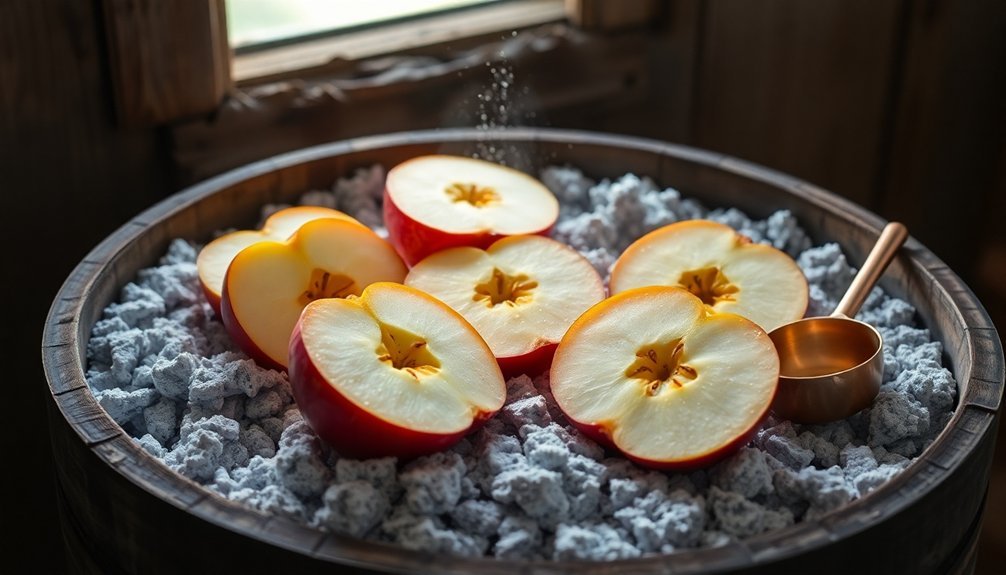
While layering fruits in wood ash is a documented preservation technique for some produce like tomatoes, there's no specific historical or modern method for preserving apples this way.
However, if you're interested in experimenting with this method, you'll need to adapt techniques used for other produce. Start by selecting ripe, unblemished apples and washing them thoroughly. You'll want them completely dry before proceeding.
For your container, choose a wooden box, cardboard container, or woven basket, and line it with paper. The ash you'll use needs to be carefully sifted to remove any sharp particles or debris.
When layering, you can follow the general approach used for tomatoes. Spread a 1.5-inch layer of sifted wood ash at the bottom of your container. Arrange your clean, dry apples so they're not touching each other, then cover with another layer of ash.
While wood ash contains beneficial minerals like calcium and potassium and can help absorb moisture, remember that this is an experimental method for apples. You might want to contemplate proven preservation methods like canning, freezing, or dehydrating instead.
Optimal Storage Conditions
Beyond experimental preservation methods, proper storage conditions play a fundamental role in keeping your apples fresh for extended periods. You'll want to maintain temperatures between 32-40°F in a dark environment, whether it's your refrigerator, basement, or root cellar. This cool darkness markedly slows down the ripening process and helps preserve your harvest longer.
Humidity control and air circulation work hand in hand to protect your apples. You should aim for 80-90% relative humidity while ensuring proper airflow around the fruit. Don't make the mistake of burying your apples in woodchips or sand, as this can trap moisture and accelerate spoilage.
- You'll feel a deep sense of satisfaction watching your carefully stored apples stay fresh throughout the winter months.
- There's an undeniable pride in knowing you're carrying forward age-old preservation techniques.
- You'll experience the joy of having crisp, flavorful apples long after harvest season ends.
Handle your apples gently during regular inspections, and remove any spoiled ones immediately. If you're planning for long-term storage, consider hardy varieties like Stayman-Winesaps.
Remember to check periodically for off-flavors or unusual textures that might indicate deterioration.
Monitoring and Maintenance

Maintaining a proper monitoring schedule guarantees your wood ash preservation system stays effective and safe.
You'll need to regularly check the pH levels of your storage environment, as wood ash is highly alkaline and can affect the quality of your preserved apples if not properly managed.
Monitor your stored apples weekly for any signs of spoilage or pest infestation. Since wood ash can help create a barrier against slugs and snails, you'll want to make certain the ash remains dry and evenly distributed.
If you notice any areas where the ash has become damp or clumped, replace it immediately to maintain its effectiveness.
When handling the ash during your maintenance checks, always wear protective clothing to avoid skin and eye irritation.
You'll need to clean your monitoring tools after each inspection to prevent cross-contamination. Keep detailed records of pH levels, pest presence, and any adjustments you make to the system.
If you discover any pathogens, implement an integrated management approach combining both ash and conventional treatments.
Remember to analyze the ash composition periodically to make sure it remains free of harmful constituents that could affect your stored apples.
Alternative Preservation Methods
Along with wood ash preservation, several proven methods exist for keeping your apples fresh long-term.
You'll find that canning, dehydrating, and freezing offer reliable ways to preserve your harvest. When canning, select firm varieties like Granny Smith or Honeycrisp, and process them in a hot water bath for 20 minutes to guarantee safe storage.
For dehydrating, slice your apples uniformly and consider adding cinnamon to prevent browning before placing them in your dehydrator or oven.
Freezing provides another excellent option, requiring you to blanch the slices briefly and give them a citric acid bath before flash-freezing. You can also transform your apples into delicious products like applesauce, butter, or jelly for extended storage.
- You'll experience the satisfaction of opening a jar of home-canned apple slices in the dead of winter, bringing summer's sweetness to your table.
- You'll love the convenience of grabbing healthy, dried apple snacks from your pantry whenever you need an energy boost.
- You'll feel proud knowing you've preserved your harvest using time-tested methods that reduce food waste and save money.
Research and Scientific Evidence
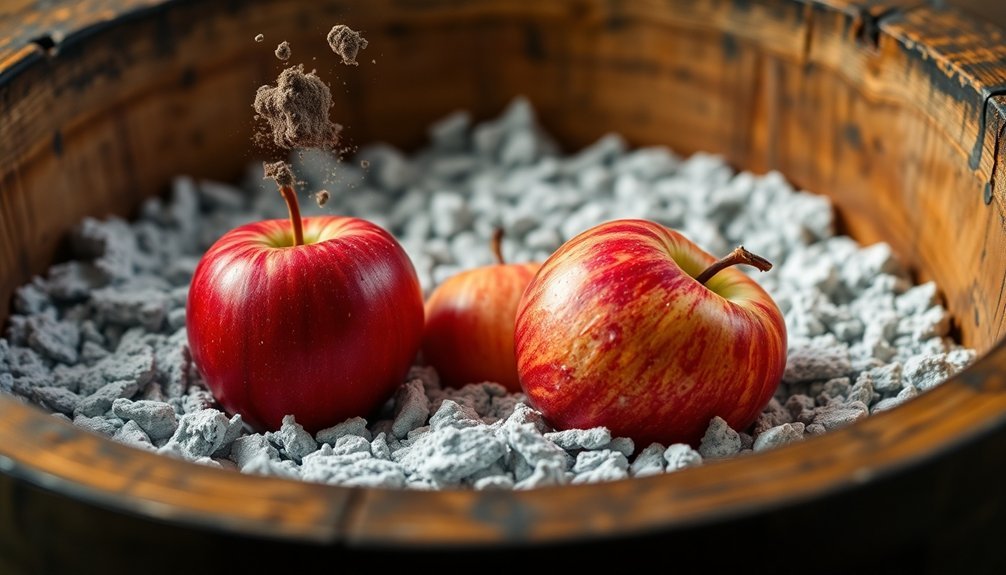
Scientists' research on wood ash preservation reveals a complex relationship between ash content and apple tree physiology. Studies conducted over three-year periods have shown that wood ash greatly impacts water use efficiency and leaf development in apple trees. You'll find that higher ash content correlates positively with water use efficiency but negatively affects leaf area index.
Research using XRF spectrometry has helped identify the precise composition of wood ash, enabling you to understand its effects as a soil amendment. Statistical analysis through IBM-SPSS Statistics 20 has confirmed considerable differences in apple stock development when using wood ash as fertilization, particularly regarding tree diameter, height, and slenderness index.
When you're considering wood ash applications, it's important to recognize that scientists have identified ideal timing for application – specifically when growth is in full swing. They've also established that wood ash acts as a liming agent, affecting soil pH levels.
Through careful analysis of δ13C and δ18O markers, researchers have identified distinct populations of apple trees based on their response to ash content, providing valuable insights into how this traditional preservation method affects tree physiology.
Benefits and Limitations
The versatility of wood ash preservation brings both valuable benefits and notable drawbacks when used for apples. You'll find that wood ash contains essential nutrients like potassium, phosphorus, and micronutrients that support fruit quality. Its natural liming effect helps create an environment that's less hospitable to certain pathogens, while historically proven preservation methods suggest its effectiveness for long-term storage.
However, you'll need to carefully consider the limitations. While wood ash can adjust soil pH, excessive use may harm apple trees that prefer slightly acidic conditions. You'll also need proper storage facilities to keep the ash dry and prevent nutrient leaching, along with protective gear for safe handling.
- You'll feel a deep connection to traditional farming methods, knowing you're using techniques that have sustained communities for centuries.
- You'll experience pride in utilizing natural, chemical-free preservation methods that honor environmental sustainability.
- You'll gain confidence in your self-sufficiency skills as you master this time-tested preservation technique.
The key to success lies in careful monitoring and moderation. You must apply wood ash during winter months and regularly test soil pH to maintain ideal conditions for your apple trees.
Frequently Asked Questions
Can Wood Ash From Burned Fruit Tree Branches Enhance the Preservation Process?
You shouldn't use wood ash from fruit tree branches for preservation, as it may contain diseases from the trees. It's better to use hardwood ash that's free from potential pathogens or contaminants.
How Does Wood Ash Preservation Affect the Apple's Natural Wax Coating?
You won't find wood ash affecting an apple's natural wax coating because this preservation method isn't used for apples at all. It's meant for tomatoes and wouldn't interact with an apple's protective bloom.
Will Apples Preserved in Wood Ash Maintain Their Crisp Texture?
You won't maintain the crisp texture of apples using wood ash preservation. There's no evidence this method works, and it's likely to damage the apple's structure. You'll get better results with proven preservation methods.
Does the Variety of Wood Used for Ash Impact Preservation Effectiveness?
Yes, you'll find hardwood ash works better for preservation since it's more nutrient-dense and alkaline. Oak, maple, and beech ash are your best choices, while softwood ash isn't as effective for storage.
Can Wood Ash Preserved Apples Be Used for Baking Afterward?
You won't get good results using wood ash preserved apples for baking. They'll be too dry and leathery. The ash's dehydrating effect makes them unsuitable for pies or desserts that need fresh apple texture.
In Summary
You'll find wood ash preservation a fascinating way to connect with ancient food storage wisdom. While it requires careful preparation and monitoring, this method can effectively preserve your apples for months. Consider trying it alongside modern techniques – you're not just storing fruit, you're participating in a time-tested tradition. Remember though, proper safety measures and high-quality materials are essential for success.

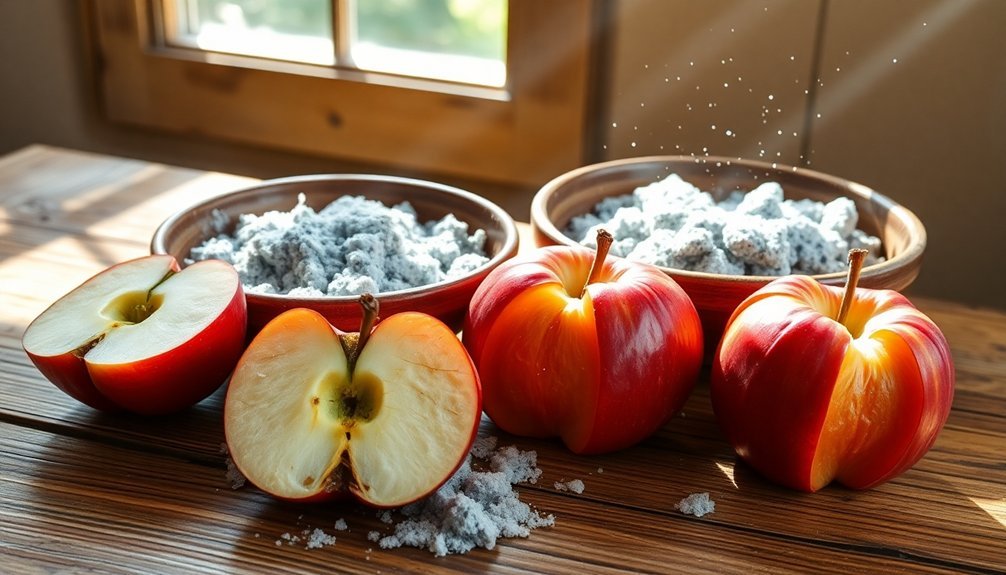



Leave a Reply